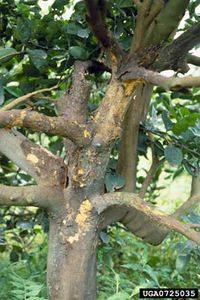Citrus psorosis virus (CPsV)
A Viral Biorealm page on the family Citrus psorosis virus (CPsV)

.
Baltimore Classification
Group V: (-) sense single-stranded RNA viruses
Higher order categories
Family: Ophioviridae
Genus: Ophiovirus
Description and Significance
Citrus psorosis virus (CpsV) is considered to be the most infectious and problematic virus pathogen of citrus plants worldwide, mostly in citrus producing countries such as North, South American and the Mediterranean. CpsV is the oldest reported citrus virus, first reported symptoms in 1896 and known viral etiology in 1933. There are a variety of different strains and symptoms which vary from mild, type 'A,' to severe, type 'B.' Symptoms can be exhibited in leaves, fruit, bark, trunk and branches. Leaf infection displays chlorotic flecks, or a decrease in chlorophyll/healthy coloring, mottling and spots; fruit may show ring-like chlorotic areas[1]. Chlorosis decreases plant's efficiency to perform photosynthesis, or ability to produce carbohydrates necessary for energy, organism support and growth[1]. The most common symptom of psorosis is deterioration of bark, such as flaking or scaling on trunk and limbs. Early stages of this deterioration are marked by blisters or bubbles which grow and later result in patches.
Citrus plants which have been reported to exhibit this virus are grapefuit, mandarin, orange and tangerine, lemon, pomelo and lime. It is economically important in the production and distribution of citrus fruit.
Genome Structure
Three species of ssRNA have been detected in the Citrus psorosis virus (CpsV), each of which is contained in a capsid made up of the same proteins. The three genomic
ssRNAs are 8184, 1644 and 1454 nucleotides in length. ORF 1 of RNA1, is located at 5’ end of the negative strand, and translates for a 280 kDa protein characteristic to that of RNA-dependent RNA polymerase.
Separated from ORF1 by 109 nucleotides is ORF2 of RNA1, which encodes a 24 kDa protein which has no homologues in the database and performs unknown functions. Conversely, RNA2 has a single ORF encoding a novel protein of 54kDa which resembles a nuclear localization signal. In RNA2, specifically the 3’ terminal untranslated region, there is a known polydenylation signal. RNA3 has one ORF which
encodes for its coat protein. The three RNAs have similar 3’ terminal regions, however, extremely differing 5’terminal regions. The virions are circular with a suggested “panhandle structure” which is formed by the base pairs of the terminal regions in each RNA strand; the first 75 nucleotides of the RNA1 termini exhibit 41% complementary components. However, results vary throughout many studies of secondary structure predictions.
Virion Structure of CPsV virus
CPsV particles are characterized as spiral filaments belonging to the group of spiroviruses (SV). They are flexible and filamentous with kinks along the surface. The diameter measures about 3nm which occur in various configurations and have two known and early differentiated contour lengths of 690-760nm and the larger which is about 4 times as long. The filaments show a pattern of repeating units every 3nm along the particle length, which could possibly be coat protein molecules which form a doughnut like structure which RNA stands pass through. When in vitro, these structures which hold the RNA strands form complex linear as well as branched structures, about 9nm and half the length of the circular contour.
Reproductive Cycle of a ______virus in a Host Cell
Viral Ecology & Pathology
No confirmed transmission has been confirmed in CPsV; “natural” causes are reported to be the contributing factor. Citrus plant areas have speculated that psorosis spreads through propagation of infected buds, soil, dodder, parasitic vines made of scales, and Olpidium-like fungus Tissue grafting has been confirmed to be one of the vectors of transmission.
References
Example:
Weir, Jerry P. " Genomic Organization and Evolution of the Human Herpesviruses." Virus Genes 16.1 (1998): 85-93.
Page authored for BIOL 375 Virology, September 2010
